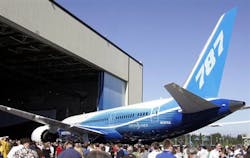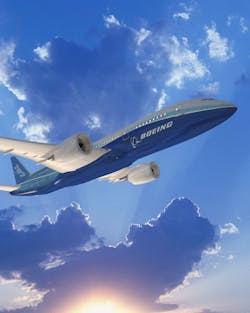Boeing tests modified 787 battery system, works with FAA
EVERETT, Wash., 18 March 2013. Boeing (NYSE:BA) engineers and executives are testing and demonstrating the safety of the Dreamliner 787’s modified battery system design in the hope of gaining FAA approval and certification for the commercial airliners to return to service.
During engineering testing, which occurs prior to certification testing, the team demonstrated that the new housing could safely contain a battery failure that included the failure of all eight cells within the battery. The "ultimate" load is the equivalent of 1.5 times the maximum force ever expected to be encountered during a battery failure. The housing withstood this pressure and did not fail until the pressure was more than three times the ultimate load.
Through another test, the team demonstrated that fire cannot occur within the new enclosure. Its design eliminates oxygen, making the containment unit self-inerting. Inerting is a step above fire detection and extinguishing as it prevents a fire from ever occurring. The design also vents all vapors by venting directly outside of the airplane rather than into the equipment bay.
"We put this new design through a rigorous set of tests. We tried to find a way to introduce a fire in the containment but it just wouldn't happen. Even when we introduced a flammable gas in the presence of an ignition source, the absence of oxygen meant there was no fire,” explains says Mike Sinnett, vice president and chief project engineer, 787 program, Boeing Commercial Airplanes.
"We drew from the new industry standard, DO311, established by RTCA, to establish our testing plan. These standards weren't available when we set the testing plan for the baseline battery and they helped us ensure the new design is robust and safe," Sinnett continues. "We intend to show, during certification, that the 787 battery meets all objectives of DO-311 and only deviates from specific requirements where the 787-unique items are not covered by the standards."
"We are following all the necessary protocols to get our new design fully approved and properly installed so that we can help our customers start flying as soon as possible. We're simultaneously moving out on an effort to resume deliveries but completing our certification work and getting the delivered fleet flying again is our first priority," says Boeing Commercial Airplanes President and CEO Ray Conner.
"The more-electric architecture of the 787 brings real value not just to the airlines but to our industry. By reducing fuel use, we are reducing our environmental footprint. This battery technology is an important part of the more-electric architecture, which is helping us to cut fuel use by more than 10 billion gallons of fuel over the life of this program,” Conner adds.
Testing to gain FAA approval of the battery enhancements has started, with the FAA's permission.


